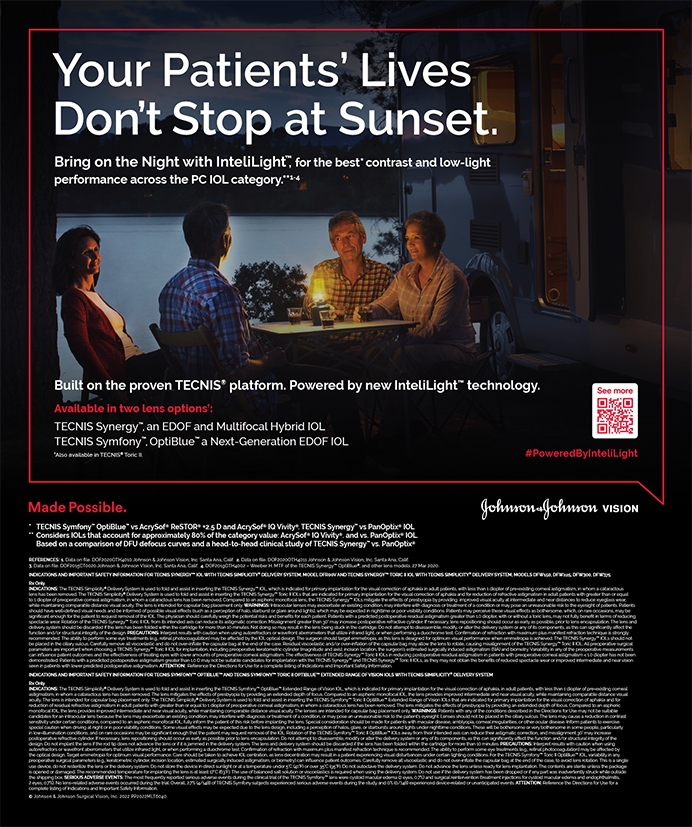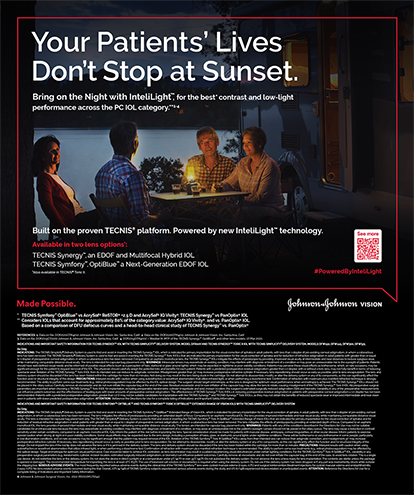


The conversation in the box above is a typical exchange we encounter when advising ophthalmologists. This is not because the subject matter is not serious or because we are taking the risk lightly but rather because there is no such thing as the Stark Anti-Kickback Statute.
Before readers become hopeful that Congress repealed it, let us explain: Although related, the Anti-Kickback Statute (AKS) and the Stark Law are independent statutes, each of which imposes considerable sanctions if violated. Reducing the risk of facing these sanctions requires understanding the prohibitions imposed by each. This article presents a brief overview of both laws and highlights the risks they present for ophthalmologists.
THE AKS
The federal AKS prohibits individuals from offering or receiving anything of value in exchange for referring a patient for the provision of services paid for by federal health care programs or in exchange for prescribing or ordering any item or service paid for by federal health care programs. (Many states have statutes that prohibit similar conduct, but the prohibition applies to all payers, not simply federal health care programs.) The penalties for violating the AKS are severe:
- A civil penalty of up to $50,000 per violation;
- Administrative penalties, including exclusion from all federal health care programs;
- Possible criminal penalties of 10 years in prison and a $100,000 fine; and
- If a False Claims Act violation is also instated, triple damages plus a penalty in excess of $11,000 to $22,000 per claim.
Because the language of the statute is written broadly, it encompasses conduct that is otherwise perfectly innocent. For this reason, Congress directed the Secretary of the Department of Health & Human Services to develop guidance (ie, safe harbors) protecting conduct that may reflect a technical violation of the statute but that does not present any risk of fraud or abuse. The responsibility to develop this guidance was delegated to the Office of the Inspector General, which has, since 1991, published more than 30 different safe harbor regulations designed to protect such conduct from prosecution.
The AKS may be triggered in multiple ways, and ophthalmologists should consider their conduct to be sure that they are acting in a compliant manner. Here we discuss the most significant areas of risk for ophthalmologists under the AKS.
Financial relationships with referral sources. Ophthalmologists may have financial relationships with other health care professionals from whom they receive referrals. The most relevant examples include optometrists and primary care physicians.
Paying for a referral for surgery is a clear violation of the AKS, but the broad language of the AKS encompasses more than a simple direct payment. For example, if a referring optometrist also leases space to the ophthalmologist, a close examination of the terms of the lease may be required to determine whether the payment reflects fair market value for the space. If the payment is higher than the fair market value, then enforcers will almost surely presume that the higher lease payment is to induce referrals. Similarly, if an optometrist and an ophthalmologist comanage patients who receive premium IOLs and the optometrist receives a share of the patient’s premium fee for the additional comanagement services performed, there will be a question of whether the additional services provided by the optometrist are adequate to justify the additional fee received.
Nonfinancial relationships with referral sources. Relationships with less direct financial interest may also trigger scrutiny from the government. For instance, ophthalmology practices often offer education to local optometrists. Education is certainly in the public interest; however, the government may question whether it constitutes something of value provided to the optometrists by the ophthalmologist for the purpose of inducing them to refer patients to the ophthalmologist. This concern becomes more acute when continuing education credits are provided or meals are served, all at no cost to optometrists.
None of this conduct constitutes a per se violation of the AKS; nevertheless, government enforcers may be concerned that the value of the education and collateral benefits were designed to induce optometrists to make referrals.
It is also important to understand that the AKS is not limited to physicians or providers of care. Payment to anyone in exchange for a referral or order may violate the AKS. The most common area of concern arises in the context of the provision of marketing services, where a third party is compensated based on the number of patients generated or revenue increase realized by the practice. Such conduct likely would be viewed by the government as a violation of the AKS.
Relationships with providers to which ophthalmologists refer. Ophthalmologists must also be sensitive to conduct when they are the referral source. For example, ophthalmologists refer patients to hospitals and ambulatory surgery centers (ASCs) for surgery. While it is unlikely that a hospital or ASC would pay an ophthalmologist for each referral (as that would constitute a clear violation of law), ophthalmologists may receive payment from these providers for serving in an administrative capacity such as medical director or committee chair. There is nothing wrong with receiving compensation for providing administrative services. If, however, the compensation is more than the fair market value of the services provided or for services that were not truly needed or not performed, the AKS can be triggered. In this case, the government will view the arrangement as a sham, designed to reward the ophthalmologist for prior referrals or to induce the ophthalmologist to admit patients.
Whenever an ophthalmologist enters such an arrangement, there should be documentation to justify the need for the services and to show that the compensation reflects the fair market value of such services. The ophthalmologist should also maintain documentation to demonstrate that the services were performed.
A referral from an ophthalmologist may also raise concern if it is to an entity in which the ophthalmologist has a financial interest and from which the ophthalmologist receives a return on that investment. The most common example is ophthalmologist ownership of an ASC. The key to ensuring compliance and avoiding an allegation of an AKS violation is to treat any dividend distribution in a manner consistent with the ownership interest of each equity owner, regardless of the volume of referrals and perceived contribution to the profitability of the ASC (see A Real-World Example on the previous page).
A REAL-WORLD EXAMPLE
If five ophthalmologists each have a 20% interest in an ambulatory surgery center (ASC), then each receives the identical dividend distribution, even if one is responsible for 50% of the referrals and another is responsible for only 10%.
In the same vein, if a sixth ophthalmologist wishes to become an equity owner in the ASC, then the price to purchase that interest must reflect its fair market value at the time and not an artificially low price to induce new ownership with the expected new patient referrals that will accompany the new investor.
Relationships with industry. Finally, ophthalmologists’ relationships with industry can trigger scrutiny. This is because government enforcers are concerned that industry may offer financial and nonfinancial benefits as an inducement to prescribe pharmaceuticals or order devices used in the delivery of services to federal health care patients (for more on this topic, see “Physician Contracts With Manufacturers”).
THE STARK LAW
The Stark Law as drafted is overly complex, and the applicable regulations developed by the government are generally incomprehensible. It has been marked by inconsistent and contradictory guidance from CMS and confusion in the health care industry. Support of these observations may be found in comments made by the late Congressman Pete Stark, the author of the legislation, who once observed that, had he known how the law was going to be applied, he never would have proposed it. This article therefore cannot offer a comprehensive overview of the Stark Law and its application to ophthalmology. Instead, it gives a broad overview of the law, contrasts it with the AKS, and presents an example of its application to ophthalmology.
There are several similarities and critical differences between the Stark Law and the AKS. The primary similarity is that both are designed to prohibit physicians from profiting financially from referring patients for services paid for by federal health care programs. The violation of both laws carries significant—even draconian—penalties. Finally, the guidance that the government has provided for each statute has been confusing and of limited assistance to the health care industry (although this comment applies doubly to the Stark Law, as will be explained later).
Ironically, the Stark Law was introduced in 1988 because Congress was unhappy about a lack of enforcement of the AKS by the Department of Justice. The Department of Justice responded that, because the AKS is a criminal statute, prosecutors had to prove the intent of the parties. This burden made successful prosecution difficult. Consequently, Congressman Stark decided that a separate law should impose an absolute prohibition, regardless of intent—what he called a bright line—against physicians’ referring a Medicare or Medicaid patient to an entity in which the physician has a financial relationship. To avoid the higher burden of proof imposed when pursuing a criminal prosecution, Congressman Stark drafted the legislation to impose civil penalties only. Those penalties, however, were extremely harsh; not only would payment be denied, but also any claim submitted as a result of a prohibited financial relationship would trigger a civil penalty of $15,000.
If Congressman Stark had his way, the prohibition would have applied to all health care services. There was concern, however, that such a broad prohibition could reduce patient access to care. Additionally, opponents of the legislation noted the existence of little hard evidence that financial relationships between physicians and entities to which they referred patients caused overutilization.
After several amendments, the final legislation targets 11 categories of services, known as Designated Health Services (DHS), that are subject to the prohibition. A complete list of the DHS is found in DHS Categories Subject to Prohibition. To complicate matters further, several exceptions were written into the statute. Thus, the scope of the Stark Law is narrower than the AKS because the latter applies to any item or service paid for by federal health care programs.
DHS CATEGORIES SUBJECT TO PROHIBITION
- Clinical Laboratory Services
- Physical Therapy, Occupational Therapy, and Outpatient Speech-Language Pathology Services
- Radiology and Certain Other Imaging Services
- Radiation Therapy Services and Supplies
- Durable Medical Equipment and Supplies
- Parenteral and Enteral Nutrients, Equipment, and Supplies
- Prosthetics, Orthotics, and Prosthetic Devices and Supplies
- Home Health Services
- Outpatient Prescription Drugs
- Inpatient Hospital Services
- Outpatient Hospital Services
Most of the DHS categories are not relevant for ophthalmology, and complex exceptions eliminate other potential applications. Certain categories, however, can apply to ophthalmology and unfortunately are not well understood.
The most common area of Stark Law risk for ophthalmologists arises in the context of diagnostic services and the relationship of these services to the rules as they pertain to physician compensation. A common formula for physician compensation analyzes the productivity of the physician and pays the physician a percentage of the revenue generated. That formula works fine for professional services such as office visits and surgical procedures, but when it comes to diagnostic services, there could be a problem under the Stark Law.
The complexity of the Stark Law and how its exceptions apply to this scenario cannot be adequately explained here. For the purpose of this article, it is sufficient to understand two things.
- No. 1: When an ophthalmologist orders a diagnostic test such as an OCT scan, the Stark Law prohibits the physician from benefiting financially (ie, through a compensation formula) for that referral unless an exception applies.
- No. 2: The Stark Law provides for such an exception as long as the physician performs the diagnostic services personally. For the exception to apply, personally performs means just that; it does not allow for supervising ancillary personnel.
This is where the confusion arises and where practices often fail to comply. Ophthalmologists correctly note that they personally perform OCT because they review the results and base treatment decisions on that review. The government, however, treats the interpretation as the professional component of the test; it does not include the technical component. Because a physician is unlikely to perform the technical component, the revenue generated from the technical component may not be considered as part of the physician’s productivity when calculating the physician’s compensation. Instead, the revenue generated from the technical component must be carved out and distributed on a basis that is not related to revenue generation.
The Stark Law’s application to ophthalmology is not limited to the highly technical calculation of physician compensation where diagnostic services are involved. Other DHS categories that are relevant to ophthalmology include outpatient prescription drugs (Part B drugs are a major consideration for practices offering retinal care) and clinical laboratory services (which may be triggered by a practice that provides diagnostics for dry eye disease). In our experience, these services are less likely to result in violations of the Stark Law. The analysis is similarly confusing, however, and practices should obtain the necessary guidance to ensure that they are operating in a compliant manner.
CONCLUSION
The AKS and the Stark Law present challenges for ophthalmologists who face the practical pressures inherent in developing and sustaining a successful medical practice while operating that practice in a compliant manner. This is particularly challenging when the statutes and regulations to which they are subject are confusing and when the limited guidance that exists increases the confusion.
Given the significant sanctions that may be imposed for noncompliance, ophthalmologists should be sensitive to the existence of these laws and seek guidance when necessary.




